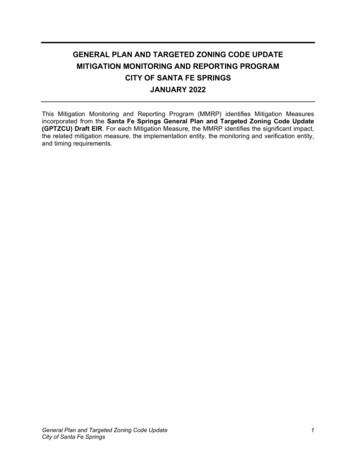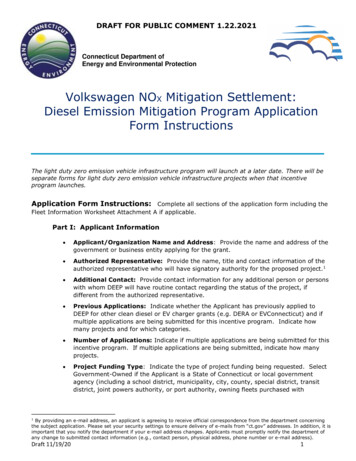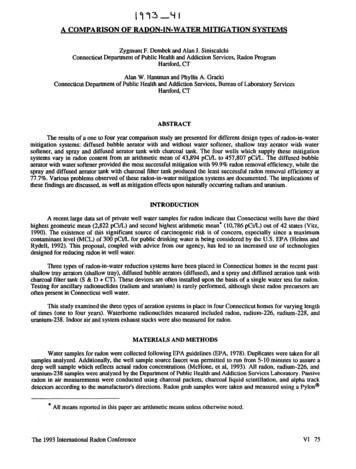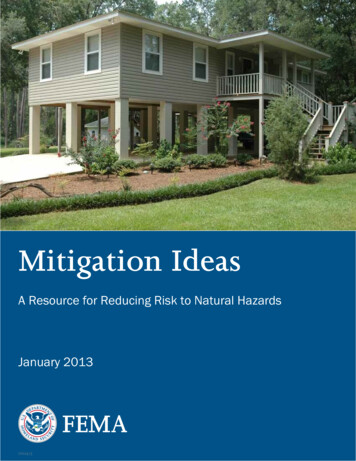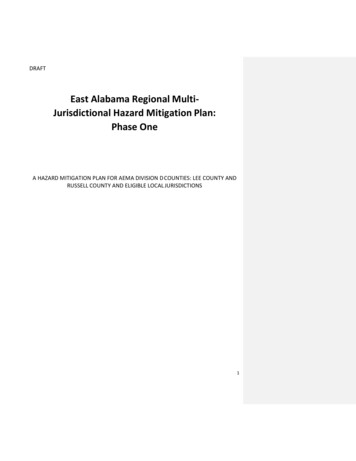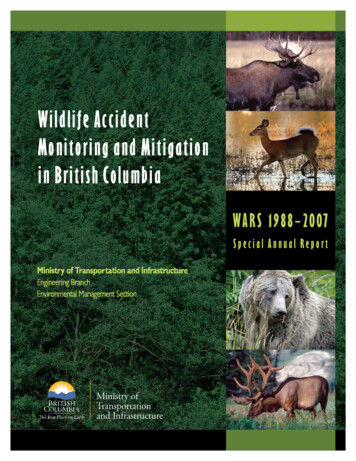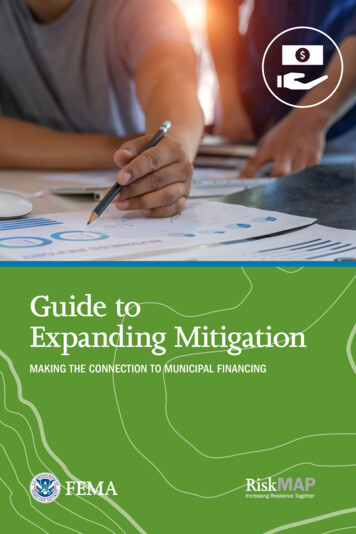
Transcription
Guide toExpanding MitigationMAKING THE CONNECTION TO MUNICIPAL FINANCING
Disasters are difficult to predict. When they strike, their impacts canhave long-term consequences for residents and the community. Toreduce the impact of future disasters and improve the resiliency ofyour community, it is important to invest in mitigation. As you advancethrough the hazard mitigation planning process, exploring optionsthat will reduce your community’s risk, it is critical to identify howyou will fund these efforts. Creating a funding strategy from multiplediverse sources will help to secure the funding necessary to keep yourcommunity safe from future disasters.Your local financial professional, whether the business administrator orfinancial officer, can help you explore creative public and private fundingsources, and consider questions such as: Does the mitigation project fit into the current budget or can it beplanned for a future cycle? Can the mitigation project be added to the Capital ImprovementPlan (CIP)? What else can be done to prioritize theproject for funding?This Guide to Expanding Mitigationexplores how community officials can workwith finance officials to support hazardmitigation planning, and how mitigationinvestments can align with communitybudgets and financial management priorities.This Guide to ExpandingMitigation is part of a serieshighlighting innovativeand emerging partnershipsfor mitigation.
PARTNERING FOR SUCCESS: WORKING WITHYOUR COMMUNITY’S FINANCE PROFESSIONALSCollaboration and partnership with finance professionals is central to themitigation planning process. They can help you identify funding sources to makehazard mitigation plans a reality. Together, you can explore a variety of fundingsources, including federal and state grants, state revolving loan programs, orbonds. Working closely with your local finance professionals offers many benefits.Involving them early in your planning process can help to ensure your communityhas a solid funding strategy to implement the hazard mitigation projects.Local financial professionals often have diverse roles; they may oversee thecommunity finance department and wear the hats of business administratorand/or financial officer: The business administrator reports to the governingbody. Their responsibilities and functions vary bycommunity. They may also serve as the municipalmanager, chief of staff, or top appointed staffperson. A business administrator will haveawareness of local priorities, the history of decisionmaking, constraints, and which departmentsand staff can make projects a success. A financial officer is often more specialized thana business administrator and primarily “keeps thebooks” for the community. Other responsibilitiesmay include budget tracking, maintaining payrollrecords, balancing funds, and crafting reports toaid administrative decisions.Federal mitigation grantsyield high dividends.According to the NationalInstitute of BuildingSciences 2019 MitigationSaves Report, for everyFederal grant dollar spentin upfront mitigation costs,the public will savesix dollars.ALIGNING RESILIENCY ANDRESOURCES IN HOBOKEN, NJYour local finance professional’sdeep understanding and connectionto the community’s financiallandscape can be a tremendousasset to mitigation projects. Theirinsight and connections can: Advise you and help to incorporatethe mitigation project intolonger term planning within thecommunity budget or CapitalImprovement Plan (CIP). Make you better positioned topursue limited mitigation funding.Your case for enhancing communityresilience will be stronger whenthe projects are built into thecommunity budget or CIP. Help you communicate withinternal partners to sharethe value of preventativeactions to keep the communitysafe, maintain operations,buttress revenues, and reducefuture losses.The City of Hoboken aligned its businessadministration and resiliency priorities sothat the budget reflects mitigation actionsthe city knows it must undertake to sustainthe community. Following Hurricane Sandyin 2012, the city started to bend financialresources toward mitigation goals. Hobokentracks all capital improvement projectsthrough robust spreadsheets and maps sothat the CIP can be codified and analyzedover time. Hoboken allocates local dollarsfor higher frequency, low consequenceevents like nuisance flooding, and federaldollars for lower frequency, high consequenceevents like hurricanes. The city usessmaller, highly visible projects to nurturecommunity buy-in then looks to state andfederal partners to take on higher costprojects. This is important for demonstratingthe efficacy of mitigation projects. Thebusiness administrator, chief resiliencyofficer, and mayor work togetherto ensure long-term investments supportthe long-term health—financial orotherwise—of the whole community.
COMMUNITY PLANNINGAND ACCOUNTING METHODSCommunity budgets represent community priorities. The budgeting process is one ofthe most important tasks of municipal government. The local governing body passesan annual budget that includes revenues and expenses, and establishes the amountof funding to programs and projects. The budget contents are analyzed and tracked.CIPs itemize projects when (because of immediate priorities) the scale, method of funding,lead time for design and permitting, and possibly a host of other considerations willnot be included in the current annual budget. For projects that have been identified forfuture years, the CIP is a document that provides details, funding, and financing options.Home elevated in Pequannock, NJ following Hurricane Sandy.The mitigation professional has a role in pitching mitigation projects during thedevelopment of the CIP. In this plan development process, the mitigation professionalshould meet with the financial professional to flesh out the project. This will helpestablish the timing for the project since the financial professional knows the mostabout the community’s revenues, expenses, and debt obligations. As a team, youwill identify the likely funding sources, including those from grants.CORE FINANCE PLANNING QUESTIONSFinancial professionals can help you think through several questions, such as: How will the community pay for or meet the match requirement? Can thecommunity pursue a bond? Are there alternative sources of funding suchas open space or stormwater management utilities? Can the project meet multiple community needs and provide co-benefits?If so, are there partner agencies that can also identify funding? What is the best timing for the project? Can the project be accomplishedin the short term, or will it have to wait for more urgent priorities? What isthe period of funding need? Are there other financial stressors that may prevent mitigation progress?When unexpected events occur, is there an option to revisit priorities in the CIP? Which staff can administer the project? Do you need to hire a contractor? What information do you need to complete the project scope? What are therequirements to bid the project (e.g., prevailing wage)? If you plan to remove buildings from high-hazard areas, how will this affectemployment and your tax base? Will lost revenues hurt the community’scredit rating? Do public safety and community resiliency take precedenceover lost revenue?COMMONWEALTH OF MASSACHUSETTS INTEGRATESMITIGATION AND FUNDINGIn 2018, the Commonwealth of Massachusetts identified 130 actionsin its Integrated State Hazard Mitigation and Climate Adaptation Plan.With the Governor’s support, the State Hazard Mitigation Officer workedwith the Director of the Office of the Capital Budget in classifying fundingsources for each action with cross-references to the five-year capitalplan. The identification of financing gaps resulted in the Commonwealthbonding for specific actions. From now on, Massachusetts will score theefficacy of the projects on the risk protection gained to influence futureresiliency decisions across agencies.
FUNDING MECHANISMSHazard mitigation projects can be funded by a variety of sources. Collaborating witha finance professional can help with identifying innovative ways to blend fundingsources such as: Federal/state/non-governmental organization grants – Grants are a source of fundingthat typically require an application with detailed support. Federal, state, and nongovernmental organizations issue grants for pre- and post-disaster periods. The grantmay not cover the full expense of the project and your community may be responsiblefor matching the grant amount. Your finance professional will help you review theterms of the grant and determine the most appropriate method to match the grant. State revolving loan programs – Revolving loan programs have been successfulnationwide in addressing infrastructure demands. In some cases, federal funding hasbeen allocated to states to establish a low or no interest loan program, or states haveissued debt to finance State programs. Unlike grants, the loan must be repaid, subjectto certain relief in interest, so that the funding goes back into the program for reuse. General obligation bonds – This is debt issued by local governments that raise moneyfor projects. General obligation bonds are commonly used and are familiar to yourfinancial professional. Communities typically apply property, sales, and/or incometaxes to pay investors principal and interest. A caution should be observed as thebond is backed by the “full faith and credit of the municipality” and this signifies thatthe government, should the budget be incapable of servicing the debt, would have toincrease taxes to guarantee the bond is paid. Other sources of funding – There may be additional sources of funding, such asfees, assessments, other bonding instruments, and private investment, that are notidentified in the above. Speak to your financial professional about the universe offunding mechanisms.MITIGATION FUNDING AT EVERY LEVEL IN GRANITE FALLS, MNTo implement its mitigation strategy, the city of Granite Falls, MNidentified 10 local, state, and federal sources for funding mitigationprojects across the city. Granite Falls used local tax increment financing(TIF) and private investment for some mitigation projects. From stateand federal sources, it received nearly 38 million over two decades.The city used those funds to reduce risk to residential, commercial, andgovernmental structures, to reconstruct a flood wall, to buy and demolishat-risk structures, and much more.
RESOURCESACKNOWLEDGEMENTSFor the Mitigation ProfessionalProject Team: John Miller, FEMA Region II; Jack Heide, FEMA Region II;Jennifer Gutierrez, Resilience Action Partners; Melissa Herlitz,Resilience Action PartnersLand Use Tool: Capital Improvement nLearn how to integrate hazard mitigation intoa capital improvement asp?docId 5384&page 1Learn about general obligation bondsWe thank the following individuals who contributed their time towardadvancing our understanding of mitigation and municipal financing:Matt Donahue, D.A. Davidson Companies; Dan Frankel, Borough of Sayreville;Patrick Kenny, Woodbridge Township; Carolyn Kousky, Wharton Risk Center;Stephen Marks, Town of Kearny; Brian Platt, Jersey City; Laurie Schoeman,Enterprise Community Partners; Caleb Stratton, City of Hoboken;Troy Truax, Michael Baker International; Sarah White, MassachusettsEmergency Management Agency; Derek Wong, Michael Baker International.Funding pportunitiesLearn about a range of government and privatefinancing for climate adaptation and resilience projectsFor the Financial ProfessionalWhat is Mitigation?fema.gov/what-mitigationLearn more about how FEMA defines mitigationFEMA Hazard Mitigation Planningfema.gov/hazard-mitigation-planningReview standards and guidance for the planning processENGAGE WITH USAre you a state, territorial, tribal, or local official interestedin making the connection between finance and hazardmitigation? Are you a finance professional interested inconnecting with local officials to reduce risk from hazards?Would you like guidance on mitigation funding sources or acopy of FEMA’s Mitigation Resource Guide? Please contactus at FEMA-R2-MT-Planning@fema.dhs.gov.
Disasters are difficult to predict. When they strike, their impacts can have long-term consequences for residents and the community. To reduce the impact of future disasters and improve the resiliency of
